Abstract
This article focuses on fundamental human rights based on a historical literature review. Methodologically, a literature review and application of the design thinking (DT) method were used in three sessions using storytelling techniques and canvas drawings with managers specializing in “smart and sustainable city” projects in Brazil. The scientific work demonstrates that, in the view of the participating experts selected according to the research criteria, there are many gaps regarding fundamental human rights in cities. The digitalization of cities, with its layers of digital governance, alone is insufficient to cover gaps in basic information for populations. With the participants’ insights, it was possible to design and develop a software application (app) under strict requirements with anonymization and geolocations of human rights violations. The tests also highlighted limitations and future improvements. It is believed that the article brings an innovative approach from a scientific point of view, with a high degree of originality due to the outcomes generated from the experiences of the authors and managers specializing in managing new “smart cities”. This governance tool has the potential to be installed and improved in more than 30 countries and thus serve almost 70 million citizens around the world. A software technology transfer has already been made to the project’s partner company.
1. Introduction
The concept of smart cities is related to the resource demand of cities. Within this general context, new cities, also known as “smart cities” or “smart and sustainable cities”, incorporate information technologies [1] and sustainability layers [2,3]. However, they still have infrastructure problems that need to be resolved [2], in addition to numerous violations of human rights defined by the United Nations [4].
Introducing a technology- and data-based governance layer [2,3] can help identify and combat human rights violations. Nevertheless, the scenario is challenging due to technological complexity and how systems are used to make decisions [3].
The topic in question is relevant and current because the violation of human rights is a severe problem that affects people all over the world and can occur for a variety of reasons, such as social inequalities, lack of primary education, discrimination, corrupt processes, and asymmetries of opportunities, among others.
The main problem found in the bibliographical research was the lack of knowledge about fundamental human rights [4] amid rapid economic development. The literature review points out that in the 21st century, many people, especially the most vulnerable [5], are still unaware of fundamental human rights [4,6,7,8].
This lack of knowledge causes people to be subjected to numerous human rights violations in society, suffering even more sharply from the fierce and accelerated inequality in economic development. Thus, there is a mix of a lack of understanding of individual rights and a lack of awareness of what is right and wrong. The lack of information can also prevent people from asking for help because the lack of access to content can limit the understanding that some acts may violate international laws [9].
The increasing urbanization of cities requires the implementation of a layer of governance. The concept of smart cities, currently under development, is based on implementing a technological layer [9] to provide data that are transformed into information to improve citizens’ quality of life [10] and bring more sustainability to cities. Within this new vision of cities, there are still infrastructure problems [11], especially in less economically developed countries. Several of these problems are addressed in the UN 2030 Agenda and the Sustainable Development Goals [12].
The scenario for meeting the 2030 Agenda concerning fundamental human rights needs assistance from decision-making systems as there are already several software solutions that can help in the fight against human rights violations, such as Shmapped [13], Corona Warn App [14], LeaveHomeSafe [15], Collega [16], Posyandu Application [17], Dandarah App [18], and the Brazilian app “Linha Direta”, which digitally work in one or more areas of human rights. The new applications are aligned with the global e-governance strategy, which can be monitored annually [19]; these solutions mainly serve people in situations of social vulnerability [20].
The world is moving towards an increasingly urban and connected society [19]. We need to raise awareness about the importance of human rights, especially in countries with greater internet access. In countries with less information on fundamental human rights, we find disparities in the literature [20,21] that can disrupt democratic processes, putting peace at risk. The Secretary-General of the United Nations, António Guterres, highlights that urban areas will attract more and more people by 2050 and are expected to make up 68% of the world’s population by this date [5,22,23].
Human rights must be used in countries as a global public policy [12,21], along with the planet’s sustainability, following the vision of the United Nations signatory countries. This view of human rights as universal brings as a backdrop a dispute over values, traditions, and forms of organization between cultures [24]. There is no consensus among nations on the limits. The topic studied in this article is very current due to the search for a comprehensive dialogue on the global agenda between all countries, such as the Conference of the Parties (COP). The next COP will take place in Baku, Azerbaijan, in 2024, while COP30 will be held in the Brazilian Amazon Region, Belém do Pará, in 2025. COP30 will be the 30th Conference of the Parties to the United Nations Framework Convention on Climate Change (UNFCCC) [25].
The Declaration of Human Rights is essential and has given rise to other declarations about women, the rights of people with disabilities, the elderly, the planet, and ecology. These later achievements come from the first declaration in 1948, where the Universal Declaration of Human Rights affirmed a concept of ethics to be shared universally [4]. The main foundation that supports this global vision is the dignity of humans, inaugurating the so-called modern concept of human rights.
When you live in cities with a more advanced standard of living and universal education (quality education has always been a crucial pillar in the development of society worldwide [26]), you live with freedom and better citizenship. You live and coexist with other limits, which is essential for the success of any smart city project worldwide. Based on this understanding, in Brazil, it is possible to talk about issues that can bring restrictions to freedom, including those caused by so-called “fake news”, such as those related to COVID-19 [27], and fake employment news, which occurs in countries that receive migrants and immigrants [6] in an attempt to manipulate public opinion through technological systems such as big data [26] and artificial intelligence [3].
Freedom can be considered a process because there is a construction of opportunities that involve people’s participation, their voices, and their actions. [28]. Local personal and social circumstances influence citizens’ freedom of action and decisions; the individual makes choices within the context in which they are inserted. The decision-making process presupposes a clear vision of each citizen’s rights, including human rights. Participatory debates influence public discussions and social interactions. Justice is a complex concept that must be considered at all levels, from the individual level to the global level [29].
When the values of a society are constructed in an unhealthy way, from the point of view of violence and violation of rights, individuals suffer. The value of democracy includes its intrinsic importance in human life, its instrumental role in generating political incentives, and its constructive function in forming values (and in understanding the strength and viability of claims to needs, rights, and duties) [30].
There is a growing recognition of the close relationship between the environment and human rights [30], which is a positive development considering the environment is a precondition for the enjoyment of human rights [6,31]. Human rights can be achieved in different ways. For example, environmental degradation [30] can lead to negative impacts of atmospheric and marine pollution on people’s lives, which can be observed internationally [32], for example, in the form of humanitarian and climate crises.
The effects of climate change have also been strongly associated with human rights violations [33]. The increasing effects caused by climate change, such as flooding and high temperatures [2], have been identified as factors that facilitate circumstances that violate human rights and dignity [31]. The authors’ vision demonstrates that human rights are extensive and that we need to incorporate respect for the natural environment and the sustainability of the planet [2,10].
Improvements to human rights and people’s well-being have already resulted from studies evaluating urban-nature-based interventions [13], including the identification of challenges to improving systems of human rights violations. The results of the literature review of articles contained in the CAPES Brazil Periodicals database and the Scientific Electronic Library Online (Scielo) helped to create the questions to be worked on in the workshops with professionals in the area in question by mainly adopting design thinking [34,35,36] with storytelling techniques [37,38] and drawing ideas on canvas [39,40]. Furthermore, the context in which the built environment of cities is located also impacts human rights, such as those arising from cities’ infrastructure systems [10,11].
In this context, this work aims to contribute to the reduction and mitigation of human rights violations—including environmental rights—through the creation of an application that helps municipal decision makers and civil society map human rights violations and make a city smarter by identifying regions in cities where human rights violations occur most frequently. Our work complements the view that human rights data are essential for corporate sustainability [41] and the planet. Initially, the application was designed to serve only Brazilian municipalities, but in the future, it may evolve to serve cities in other nations.
In this work, we used the Universal Declaration of Human Rights [4] and the Sustainable Development Goals [12], which require understanding of the foundations of human rights and their affirmation movement, both at global and national levels, in the context of the affirmation process of human rights that considers social construction as something that goes far beyond laws and seeks to legitimize the positions of different groups in society. Our focus on human rights is precisely this social construction that seeks materialization and means to materialize different historical and social contexts that reflect society’s values.
Keeping data updated in large volumes is a significant challenge, especially when we understand the technological revolution that undoubtedly affects all aspects of human life [3,9,10,26]. This challenge is understood to be a gap to be faced in developing the project. From there, if it is possible to meet the requirements, the project will even be able to collaborate more effectively in constructing public policies.
The technologies used in smart cities often include systems that allow data to be identified [3,10,26] and then direct governance towards developing solutions to benefit communities that live in them and use the countless facilities a smart city brings for the population.
For future applications, one of the products to be developed will be complemented by technologies such as anonymization and georeferencing. The data will be stored in secure information systems of the project’s partner company. They will be essential for developing future studies and sectoral diagnoses, enabling new strategies that help correct aspects linked to the violation of human rights and the rearrangement of public policies [2,10] in smart and sustainable cities.
Considering the technological resources present in the main citizen application models, the plan is to develop content and information for access through a responsive website compatible with operating systems such as iOS and Android (for a functional prototype). This will allow regions that are facing more violations of human rights to be mapped and, in this way, help the organization, which is present in several Brazilian states and in more than 30 countries, develop guidance, prevention, and mitigation solutions in its areas of activity.
This study is justified not only by its originality and magnitude but also by the importance and relevance of preserving human rights based on the comprehensiveness of sustainability actions, whether social, environmental, or economic. Fundamental principles, such as the dignity of the human person, are universal and have no borders.
This research directly contributes to meeting the 2030 Agenda, in particular SDG 11 [8,12], mainly in the aspects of the goal of universal access to public spaces that are increasingly safe, inclusive, accessible, and green, especially for women and children, older people, and people with disabilities. Furthermore, this research contributes to SDG 16 [8,12], mainly in the goal of public access to information and protecting fundamental freedoms through national legislation [41] and international agreements.
This article is structured in sections as follows: (1) Introduction, including a literature review; (2) Materials and Methods, which describe the methodological approach divided into two stages: (a) bibliographic references and choice of research participants with the criteria adopted (reference descriptors, period of articles, and chosen databases) and (b) method of conception and development of the work and the techniques applied for design thinking (development of workshops, storytelling process for building personas, and construction of canvas), process of generating insights with experts and drawings of three canvases (empathy map, empathy governance map, and value proposition), application of the continuous improvement process during DT drawing improvement sessions (complete design thinking process), and development of a usable software wireframe (app); (3) Discussions and Learnings, based on insights and reviews of the application with an emphasis on the experience of expert users as well as identification of improvements, research limitations, and future studies; (4) Conclusions; and (5) References.
2. Materials and Methods
2.1. Summary of the Methodological Approach and Choice of Target Audience for the Research Work
To begin the research, a literature review was carried out with the identification of articles using the descriptors “smart city”, “smart and sustainable cities”, “human rights”, “violation of human rights”, and “freedom and justice” in Portuguese and English. The terms were combined, the summaries read, and priority in the selection occurred for articles that were more in line with the theme researched between the period 2018 and 2024 in the following databases: Portal de Periódicos da Coordenação de Aperfeiçoamento de Pessoal de Ensino Superior (CAPES Brazil) and Scientific Electronic Library Online (Scielo).
Considering that human rights violations are a challenge in smart cities, the authors needed to choose a suitable method for interactive processes to create insights and solutions. To think of appropriate solutions to the research problem, which is complex by nature, it was necessary to involve researchers from five universities in Brazil and technical managers from one of the largest energy companies in the world operating in Brazil in implementing smart city projects.
The development of reflections and requirements for building the product is the central object of this work, which used the design thinking (DT) method in three different workshops with professionals chosen from the partner company. The DT iterative method is known worldwide for its constant evolution since its launch in 2009 [34,35], including storytelling techniques [37,38,42] and business model canvas constructions [39,40].
The combination of the literature review with an appropriate method allowed the development of a functional software prototype called “My Human Rights—Smart City” in version 1.0, which can contribute to the mitigation of human rights violations [4,43] in the future, mainly focusing on Brazilian locations. The project partner company is headquartered in Italy and has a presence in several continents worldwide [44,45], including several states in Brazil.
The literature review methodology was bibliographic, and the DT method was applied through empirical research [42] using a combination of action research and intentional sampling. The selection criteria considered managers who had experience in management, sustainability, and human rights themes in addition to working in strategic areas; in this way, it was possible to consider whether the chosen target audience met the research criteria and whether they suited the present study. In summary, the methodological approach consisted of the following steps:
- Literature review with the identification of articles using the descriptors “smart city”, “smart and sustainable cities”, “human rights”, “violation of human rights”, and “freedom and justice” in Portuguese and English. The terms were searched in combination, and the abstract analysis considered articles between 2018 and 2024 in the databases Portal de Periódicos da Coordenação de Aperfeiçoamento de Pessoal de Ensino Superior (CAPES Brazil) and Scientific Electronic Library Online (Scielo).
- Definition of the target audience for the research through intentional research, namely, managers specializing in management, sustainability, and human rights from the research partner company.
- Definition of the workshop application method, including action research with an exploratory bias through design thinking (DT) to generate insights using storytelling and business model canvas (BMC) techniques.
- Creation of a functional software prototype for demonstration to workshop participants, where collective concepts could be applied and experimented through a responsive website for iOS and Android operating systems.
- Identification of points for improvement and future studies in order to use the first developed version of the software as this governance tool can potentially serve more than 30 countries and 70 million citizens worldwide.
2.2. Design Thinking (DT) and Its Application
Solving problems creatively and innovatively is critical for rapid and constant change. Design thinking (DT) is a method that can help develop this skill as it is human-centered, highly collaborative, experimental, optimistic, and visual.
Adopting action research with an exploratory bias in DT was fundamental for the authors to adequately understand the phenomena related to the participant’s areas of expertise, namely, management, sustainability, and human rights. At each DT session, professionals from the project’s partner company participating in the workshop could use weights to re-evaluate the production of insights and reconstruct the business model canvas (BMC).
With each new round, the participants balanced the weights, and, when necessary, the BMC was reprocessed, generating new conceptual maps. From the final version, it was possible to build a functional prototype of the software, registered through a certificate at the Brazilian National Institute of Industrial Property (INPI) under number BR512022002779-8, which was transferred to the partner company to apply to the smart city projects it develops worldwide, especially in Brazil.
The central point of this DT approach is to delve deeply into customer needs; in the case presented, the challenge was to incorporate the users’ journey to create practical solutions to their problems. This is what is called an empathetic connection. The more precise the perception of the problem from the customer’s point of view, the greater the possibility of finding solutions that resolve their pain. It can be said that design thinking offers a set of technical premises and tools to integrate the needs of customers or, in this case, users.
For an innovation to be successful, design thinking (DT) works with three main dimensions:
- Desire and ability: Does the solution meet a real customer need?
- Technicality: Is it possible to develop a technically viable solution that is better than what is currently available?
- Feasibility: Is there a viable and sustainable business model for this solution?
Brown [34] has the following perspective: the first step is to identify the inspiration, problem, or opportunity that motivates the search for solutions; the second step is ideation, which is the process of generating, developing, and testing ideas; and the third step is implementation, which is the path from the design studio to the market. His contemporary, Martin [46], has the following quote to explain the method: “The design thinking process is not a linear sequence of steps. Instead, it is a cyclical, iterative process in which the different phases overlap and feed into each other”.
The four popular phases of design thinking [34] are as follows: (1) exploration: understanding the problem and users’ needs; (2) synthesis: prioritizing what is essential and identifying opportunities; (3) creation: generating innovative solutions; and (4) experimentation: prototyping, testing, and refining solutions.
Although Brown’s work [34] was more influential in popularizing design thinking (DT) than Martin’s [46], it was not these authors but Richard Buchanan who coined the term [47].
The skills associated with this stream help us apply design thinking to solve real-world problems effectively. This can be learned, but it takes effort. For example, when understanding a problem, it is necessary to free yourself from the constraints of existing mental models to seek new solutions. Applying design thinking techniques to solve business problems can help solve problems present in the governance of smart cities.
Today, design thinking is already consolidated in the corporate culture of large companies, such as Apple, Coca-Cola, Enel, Nike, IBM, and Procter & Gamble (P&G). These organizations are recognized for integrating design thinking into their corporate strategies, achieving excellent results.
2.3. About the Research Participants—Design Thinking
The group, composed of eight specialists, included men and women who were employees of the largest private group in the Brazilian electric sector that plays a leading role in the development of renewable energy sources in the country, acting in the entire energy chain in the areas of generation, distribution, transmission, and commercialization as well as energy solutions aimed at smart cities.
Among the invited professionals, people from the following areas participated: finance, legal, planning and control (two professionals), circular economy, and trading (energy trading, sustainability, and market).
2.4. About the Workshop—Design Thinking Session
With continuous improvement in mind, design thinking (DT) is a user-centered design session [47]. This means putting the customer or user at the center of everything. Design thinking uses some design tools to co-create with the customer or user the product or service they want, which changes their habits and improves their experience. See the steps used by the authors for each design thinking session (Figure 1).

Figure 1.
“Steps to a Design Thinking Session”, adapted from Tim Brown.
DT is a practical approach to solving problems using a nonjudgmental approach. It is a method for stimulating ideation and insight when addressing issues related to future information acquisition, knowledge analysis, and proposed solutions. We encourage experimentation to build a product oriented to the actual need proposed in this study: “The invention can only be considered an innovation if accepted by the people involved” [35].
During the sessions, three client-centered criteria (Figure 2) were used: what makes sense to people, what is likely to become part of a sustainable business model, and what is functionally possible shortly.
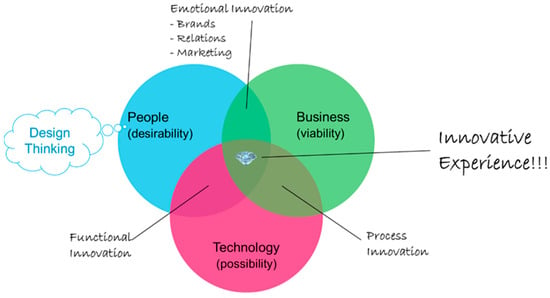
Figure 2.
“Phases to Innovate in Design Thinking Sessions”, adapted from Tim Brown.
The process lasted three workshops on different days, the first of which was used to understand the problem, identify needs (empathy map), and process the interpretation and reinterpretation of the problem (Figure 1, Figure 2 and Figure 3). On the second day, the ideation (canvas—value proposition) and the prototyping (rapid problem solving) began. On the third day, we had the testing and improvement process.
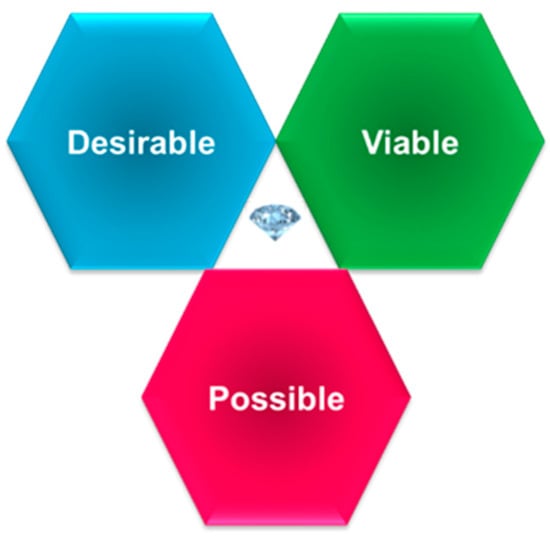
Figure 3.
“Design Thinking Method Approach”, adapted from Tim Brown.
2.4.1. Design Thinking—Day 1
We started the session by developing a mind map, which guided the participants to create a list of names to identify the positive and negative perceptions that would guide the final choice of the product name: “My Human Rights—Smart City”.
To create the maps, we followed the business model generation canvas methodology, which was developed to help design a specific customer profile, which we call a “persona”. In this way, it was possible to visualize the business model through the eyes of the “persona” represented in each empathy map, sometimes with the eyes of society and sometimes with the eyes of smart city governance.
The map was fed, bringing the focus to the persona, which allowed us to see how the “persona” perceives the value generated by the product proposed here.
In this way, we invited participants to fill in empathy maps, dividing the session into two moments: the first in the role of smart city residents and the second in the governance of the same smart city.
In the first exercise, they answered questions from the perspective of the population regarding the issue of human rights violations based on their present understanding. The result is presented in Figure 4.
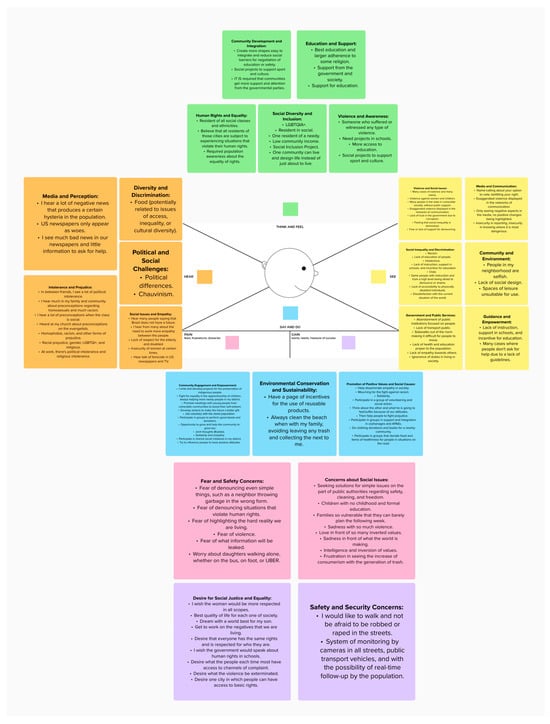
Figure 4.
“Canvas Empathy Society Map—Empathy and Needs, the Perspective of Society”, by the authors.
Figure 4 (empathy map) does not have a strict order for completion. Still, based on several authors’ experiences, it is recommended to carry out an interactive and holistic process to create empathy with participants towards the research topic. The process can start in the following order:
- Context (SEE—what the user sees, observes, and encounters daily; HEAR—what the user hears and impacts their experience). The result is presented in Figure 5.
- Participants express anxiety about violence, inequality, and media negativity. They see widespread violence, exaggerated online content, and distrust in government due to corruption. Social concerns include racism, intolerance, lack of education, and feelings of discrimination on grounds such as class, gender, religion, and sexual orientation. Fear, a lack of support for reporting, and negativity from the media exacerbate these issues. Brazilians also see public spaces as neglected, lacking essential services such as transportation and healthcare. They yearn for better social design, empathy, and guidance to address these challenges.
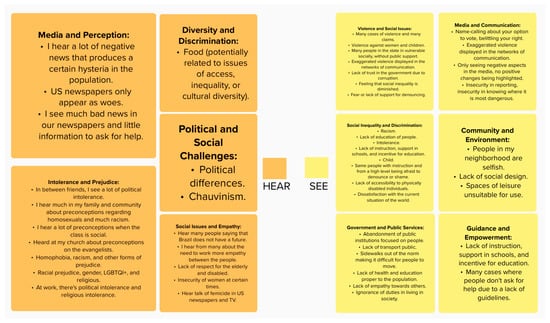
Figure 5.
“Hear and See: Shaping User Journeys”, by the authors.
- 2.
- Actions and expressions (DO—describe what the user does and specific actions and behaviors related to the objective; SAY—write down what the user says, thinks, complains, and comments). The result is presented in Figure 6.
- Participants combine personal action with community support, addressing issues ranging from inequality and youth empowerment to environmental conservation and social compassion. Through texts, projects, beach cleaning, and volunteering, they defend indigenous preservation, fight for fairer childhoods, empower the vulnerable, and defend sustainability. Empathy fuels every step, encouraging others to build a better future through shared initiative, positive influence, and a deep belief in helping individuals and communities grow.
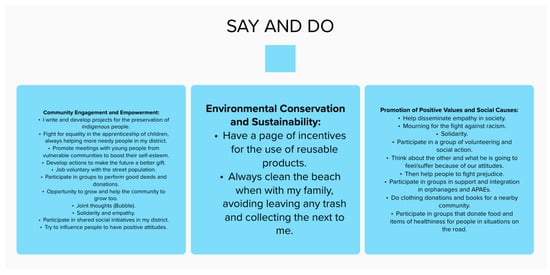
Figure 6.
“Say and Do: Shaping User Journeys”, by the authors.
- 3.
- Motivations and emotions (THINK—explore thoughts and beliefs; FEEL—focus on the user’s emotions and feelings). The result is presented in Figure 7.
- Diverse, woven, tight communities yearn for seamless integration, open education, and safe havens. Sports and culture ignite unity by acknowledging vulnerability and championing equal rights. From government halls to houses of faith, support flourishes for education’s torch. LGBTQIA+ and low-income families all find embrace—empowered to design their lives, not just endure. Education, awareness, and social upliftment combat violence, paving a path to thrive with compassion.
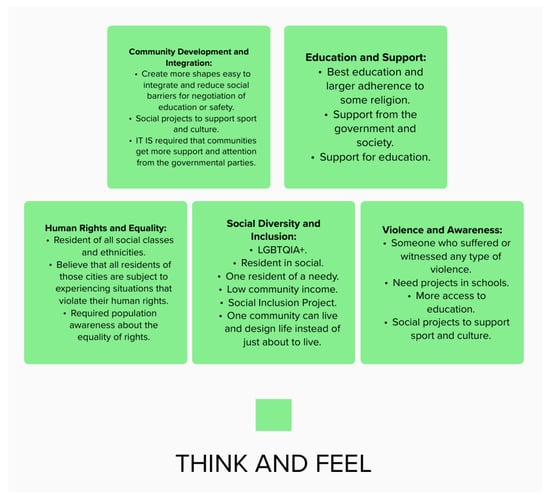
Figure 7.
“Think and Feel: Shaping User Journeys”, by the authors.
- 4.
- Pains and Gains (PAIN—represents pain points; GAIN—fulfillment of gains and desires). The result is presented in Figure 8.
- Participants paint a stark picture of societal fears and frustrations, yearning for a fairer and safer world. They fear reprisals for speaking out and witnessing violence and worry about their daughter’s well-being. They see children lacking education, families struggling, and rampant consumerism. Yet, amidst the sadness, glimmers of hope shine through. They aspire for gender equality, a better life for all, and access to fundamental rights. They dream of a world where people are respected, violence is gone, and complaints are heard. Ultimately, the author’s plea is for a city where walking the streets does not evoke fear but a sense of security and belonging.
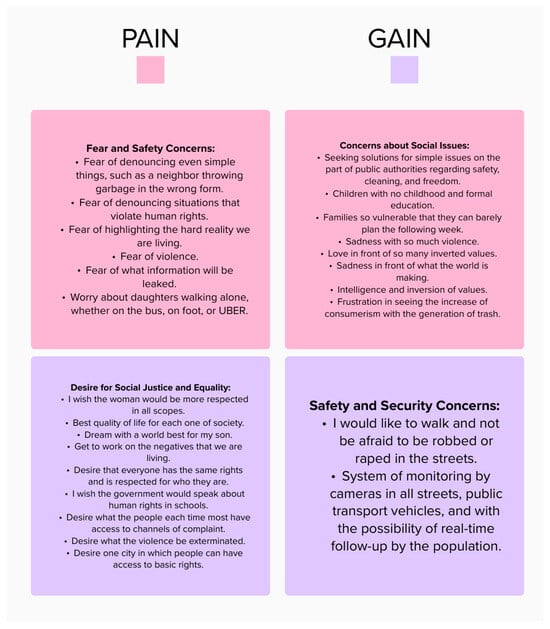
Figure 8.
“Pain and Gain: Shaping User Journeys”, by the authors.
The empathy map should not be used as a script; it is a flexible feedback tool that must be adjusted at any time during the workshop. The ultimate objective is to win over participants or users with empathy, aiming to understand what they think or feel about the theme. It is a first step towards achieving an accurate participation process.
In the second moment of the first day, participants answered questions about how the governance of a smart city should act to mitigate cases of human rights violations highlighted by the population. It is worth noting that participants are influenced by their own experiences and those closest to the governance systems. The result is shown in Figure 9 below.
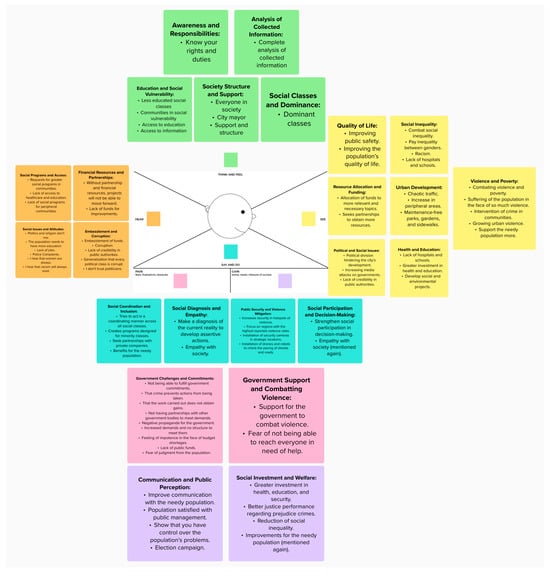
Figure 9.
“Canvas Empathy Governance Map—Felt Reality in the Role of System Governance”, by the authors.
For the constructions presented above (Figure 4, Figure 5, Figure 6, Figure 7, Figure 8 and Figure 9), both “personas”—society and governance—answered the following questions: “What does he see?”, “What does he hear?”, “What does he think and feel?”, “What does he do and say?”, and “What are his pains?” and “What are your earnings?”.
Figure 9 (empathy governance map) is filled in according to the analyzed governance system’s context (felt reality). The process can start in the following order:
- What the user sees. The result is presented in Figure 10.
- Users yearn for a city free from violence and poverty, with resources prioritized for areas of need. Political division hinders progress, while crime plagues communities. Media scrutiny intensifies as social inequality widens and chaos engulfs traffic. Violence against women rises, while parks and schools crumble. Public trust wanes amidst infrastructure woes and peripheral expansion. Users crave interventions such as social–environmental projects, robust healthcare and education, and improved public safety, ultimately seeking a better quality of life for all. These diverse anxieties paint a stark picture, demanding solutions across the social spectrum.
- What the user hears. The result is presented in Figure 10.
- The user’s map paints a picture of a community yearning for progress but hindered by a lack of resources and distrust. They see projects stalling due to funding problems, suspect misappropriation of funds, and long for expanded social programs. Access to healthcare and education is limited, particularly in the outlying areas. The mix of politics and religion raises concerns, while a belief in the need for better education resonates. Job scarcity and a perceived lack of improvement funds add to the frustration. Woven throughout is a deep skepticism: corruption is assumed, racism is seen as entrenched, and public authorities lack credibility. This widespread distrust in politicians, often seen as universally corrupt, and reports of police misconduct paint a bleak picture of societal trust. Ultimately, the map reveals a community burdened by negative perceptions and yearning for a more just and equitable world.
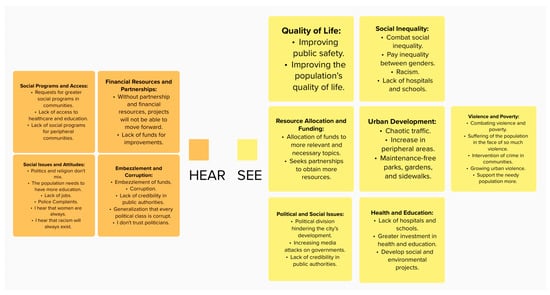
Figure 10.
“Hear and See: Shaping User Journeys in a Governance View”, by the authors.
- 3.
- What the user thinks and feels. The result is presented in Figure 11.
- The user seems concerned about societal inequalities, particularly regarding access to education and the vulnerability of certain groups. They value inclusivity, recognition of various classes and communities, and access to information and rights. They hope for leadership solutions, individual courage, and thorough analysis to address these issues.
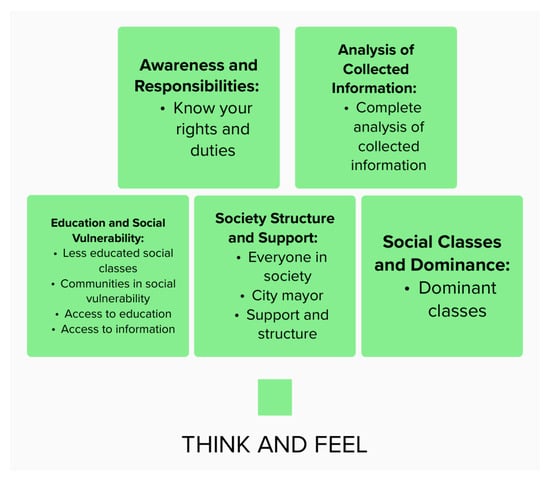
Figure 11.
“Think and Feel: Shaping User Journeys in a Governance View”, by the authors.
- 4.
- What the user says and does. The result is presented in Figure 12.
- Aiming for action beyond security cameras, this initiative seeks holistic solutions to violence. It fosters social cohesion through empathy, minority-focused programs, and cross-class collaboration. Partnerships with private companies bring resources, while data-driven approaches like street-scanning robots and violence hotspot analysis guide effective solutions. Ultimately, this plan prioritizes the underprivileged and empowers community participation for a safer, more equitable future.
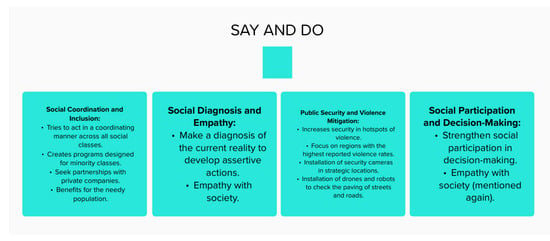
Figure 12.
“Say and Do: Shaping User Journeys in a Governance View”, by the authors.
- 5.
- Pains. The result is presented in Figure 13.
- The government wrestles with fulfilling promises, crime-hindering action, and work yielding scant results. Partnerships are scarce; hostile public relations and the fear of neglecting those in need gnaw. Demands surge without resources to match, leaving a feeling of impotence. Support for tackling violence is sought, as is public funding. Judgment by the people haunts them. These anxieties reveal the government’s struggles—execution hurdles, resource deficiencies, external pressures, and fear of public disapproval. These are crucial to understanding public administration’s obstacles and service delivery challenges.
- 6.
- Gains. The result is presented in Figure 13.
Public administration aims to enhance its positive impact by actively engaging with the needy population through improved communication. By prioritizing investments in health, education, and security and demonstrating effective control over public issues, it seeks to gain the population’s satisfaction and achieve better judicial performance in sensitive areas like bias crimes. Ultimately, the desired gain is to reduce social inequality, leading to tangible improvements for the needy and securing success in various spheres, including election campaigns. Collectively, these goals represent a vision for progress and societal benefit.
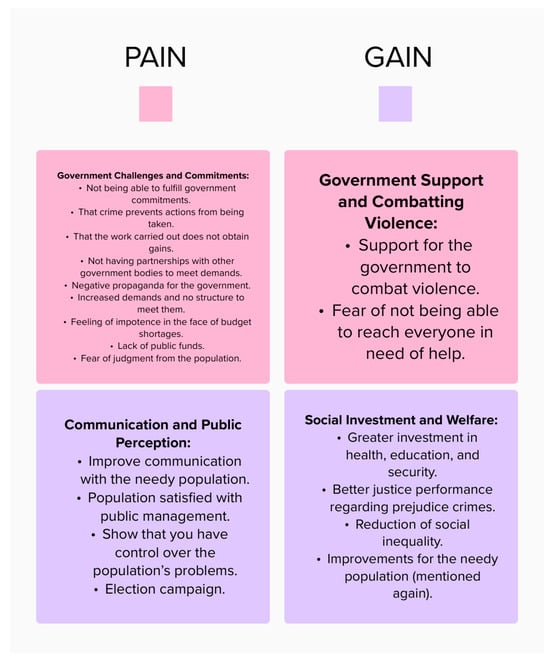
Figure 13.
“Pay and Gain: Shaping User Journeys in a Governance View”, by the authors.
2.4.2. Design Thinking—Day 2
The product was presented to the participants on the second day, who could try, analyze, criticize, and suggest it. For this, we used a creative process called ideation. Here, in addition to obvious solutions, we were able to increase the innovation potential of the solution by taking advantage of collaboration and the strengths of the teams, thus discovering unexpected areas of exploration and creating fluency (volume) and flexibility (variety) of ideas. The result is presented in Figure 14.
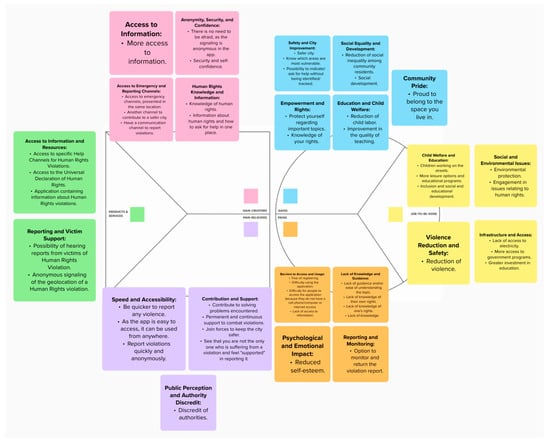
Figure 14.
“Value Proposition—Functional Preprototype from Canvas to Code”, by the authors.
The design thinking sessions were held on different days so that all participants could evaluate and re-evaluate the canvas generated, and over time, they could return with proposed improvements. In the case of Figure 14, the interval was even more critical because, between the second and third sessions, the developers had to implement all the improvements designed and placed in a canvas (value proposition).
Figure 14 (value proposition) integrates these insights into the value proposition; the solution can address the identified needs, alleviate pain points, and promote active participation and a sense of safety and support in the community. The process can start in the following order:
- Customer jobs. The result is presented in Figure 15.
- Families striving for a better life face varied challenges: contributing to income while raising children, finding enriching activities, ensuring safety, and accessing energy and government aid. Each need demands targeted support: alternative child support, educational programs, violence reduction strategies, sustainable energy solutions, and streamlined access to crucial government programs. We can empower families to build brighter futures by addressing these diverse challenges.
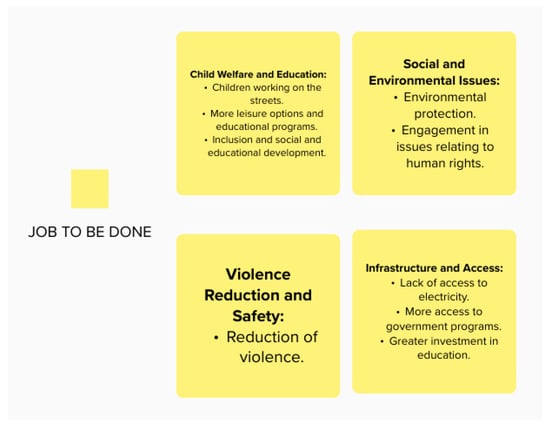
Figure 15.
“Job to be Done”, by the authors.
- 2.
- Pains. The result is presented in Figure 16.
- Potential users face obstacles like fear during registration, requiring empathetic communication and safety assurances. The app’s difficulty requires an intuitive interface, tutorials, and easy navigation support. A lack of understanding points to the need for simple educational resources. Users unaware of their rights suggest the need to incorporate rights education into the app’s value proposition. Finally, accessibility challenges due to device or internet limitations necessitate equitable access strategies, including offline options and public internet partnerships.
- 3.
- Gains. The result is presented in Figure 16.
- This list advocates for protecting children through reduced labor, fostering alternative development paths, and nurturing a safe learning environment through quality education and relevant resources. It emphasizes empowering individuals with knowledge of their rights and tools for self-protection, along with tackling social inequalities for a more equitable and inclusive community.
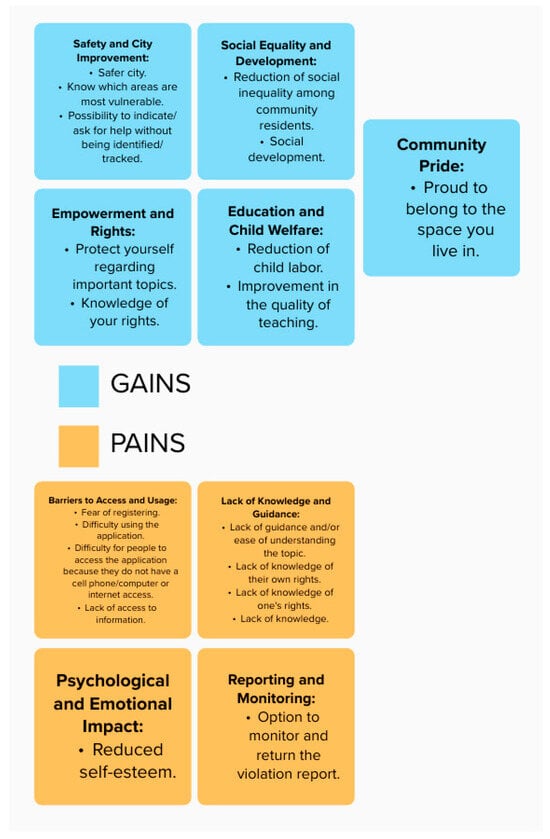
Figure 16.
“Pains and Gains”, by the authors.
- 4.
- Products and services. The result is presented in Figure 17.
- This proposed app combats human rights violations by offering specialized support channels, access to the Universal Declaration, and a centralized database of reports. Victims can anonymously share their stories, fostering empathy and community action, while anonymous location flagging prioritizes security and encourages widespread participation.
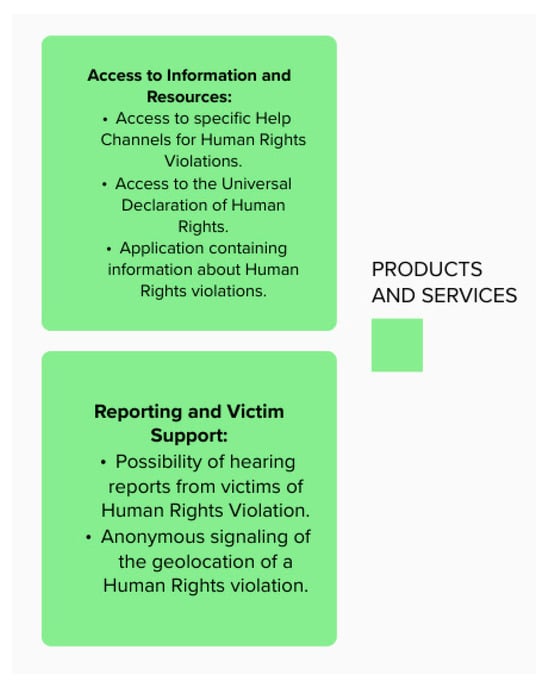
Figure 17.
“Products and Services”, by the authors.
- 5.
- Gain creators. The result is presented in Figure 18.
- Empowering you with a safer city: Our app lets you report emergencies, find human rights information, and contribute to community safety, all anonymously. It is your one-stop platform for knowledge, security, and a voice against injustice.
- 6.
- Pain relievers. The result is presented in Figure 18:
- This app tackles violence head-on by streamlining reporting, offering immediate support, and fostering community involvement. Easy access, anonymity, and ongoing assistance empower users to address issues directly, building a safer city with trust and collaboration, not fear and isolation.
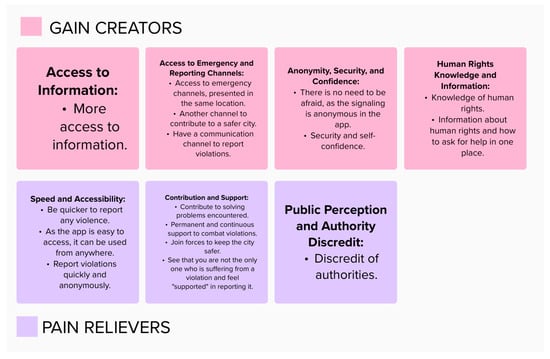
Figure 18.
“Gain Creators and Pain Relievers”, by the authors.
2.4.3. Design Thinking—Day 3
In the third and final stage of design thinking [34], we had a moment of testing and improvements, in which participants received the access link to the My Human Rights—Smart City application and were able to try out the new functions of the product using a canvas (value proposition).
The testing step within design thinking goes beyond “now that the prototype is ready, just test”. When using the word “test” while talking to the participants of the design thinking session (Figure 19), it soon came to mind that this step consists only of checking that nothing is wrong. In design thinking, when we talk about testing, it makes much more sense to evaluate the person’s experience when building this prototype. Therefore, we resignified the word test for the understanding that followed.
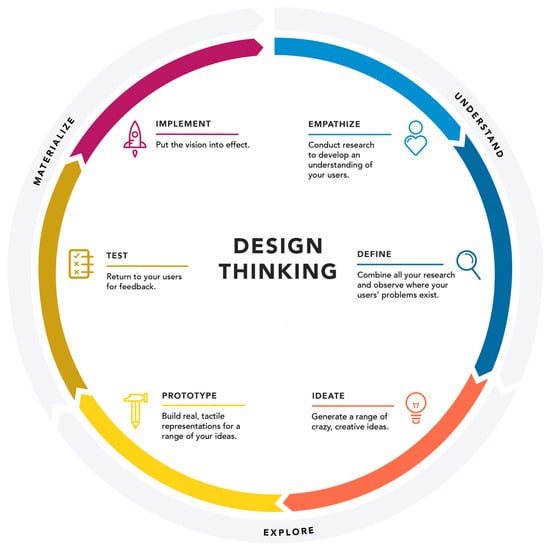
Figure 19.
“How to Apply Design Thinking”, adapted from NGG GROUP and SEBRAE Brazil.
To make this possible, we asked the following questions to the participants:
- What was your understanding as you navigated through the solution?
- How did you feel while trying out the solution?
- How would using My Human Rights—Smart City impact your daily life?
These analyses made it possible to better format the product for use, considering the participants’ navigation experience, depending on the needs presented and identified with the project. This was the last stage of testing and adjustments to the version implemented and transferred to the project’s international partner company.
3. Discussions and Learnings with the Software Tool, Developed with the Possibility of Geolocating Violations of Fundamental Human Rights
During the interactive process of developing the canvas from the first session to the last session, the authors were able to observe an incremental improvement in the research results through the DT method, with the application of storytelling and canvas design techniques that were visual, conceptual summaries to understand what experts thought was important.
The specialized managers divided themselves into two versions: one representing the role of city citizens and another representing the governance manager of a town that wishes to become more intelligent and sustainable.
Preventing human rights violations in a smart and sustainable city is a challenge that can be achieved. The choice of people to participate in this scientific research was fundamental; their experience with smart city projects and managing sensitive issues was a differentiator in this process.
When people talk about raising awareness among the population about the importance of human rights and the risks of violation, it seems trivial, but it is not; often, not even the most capable and literate citizens in a society have a global vision of the issue of fundamental human rights.
The stories told through the “My Human Rights—Smart City” application are capable of generating empathy and understanding from lay citizens. During the process of building solutions, the average profile of citizens helps the experts themselves understand how far away formal language is in national and international legislation from ordinary citizens, especially the most vulnerable. Here, all possible types of vulnerable populations that experts could think of were considered in addition to their everyday actions and behaviors.
It can be highlighted that the “My Human Rights—Smart City” application was able to implement the following contents:
- Summary of what is fundamental human rights;
- Summary of the Universal Declaration of Human Rights;
- List of human rights violations, including environmental rights;
- Channel to report human rights violations, with geolocations of human rights violations by type of violation, city, and neighborhood;
- Video content with reports of violations suffered by other people, serving as an inspiration.
An option made by the authors with the target audience that participated in the process of building the software requirements was to anonymously identify the regions of a city where human rights violations are taking place without exposing people; it was through their spatial data geographics that the location could be identified without the need to collect any sensitive data from users of the “My Human Rights—Smart City” application.
The process uses a conceptualization of geolocation that works on topology; that is, through reports of violations, the system interprets the intersection zone and determines whether there is geographic overlap and whether the types of violations are similar. Finally, it informs the managers via an exclusive communication channel, in addition to providing communicators with the main channels available on the internet and, if applicable, in their region. Unfortunately, many cities still do not have adequate information channels for this type of complaint.
Given the insights generated at each stage of the DT application (inspire, ideate, and implement) [48], the authors demonstrated the importance of this application for transforming cities, neighborhoods, and regions into smarter and more sustainable ones. The most significant contributions of this application to smart cities can be highlighted below:
- It raises awareness among the population about the importance of human rights and the risk of violation.
- It adheres to the method used in studies, including the design thinking (DT) sessions with the participation of users specializing in project management for smart cities.
- It uses storytelling to prevent human rights violations in a smart city.
- It notes that the content included in the “My Human Rights—Smart City” application can be considered a sufficient first version but requires improvements with use by the general population.
- It finds that, in smart cities, the use of technology has two biases: the first privileges those who have access to the internet, and the second further excludes people who do not have access to this type of technology.
- It shows the process of continuous application improvement needs to be constant, with users sponsoring its use in the regions where the projects are implemented.
Many improvements are possible with the interaction of more users through the design thinking method. The studies carried out indicate that the prevention of human rights violations is a complex and nontrivial matter. As suggestions for new researchers, here are some tips for improvements:
- Include video content with testimonies from people who have suffered human rights violations. These testimonials can be even more effective in raising awareness about the topic.
- Include video content with tips on how to prevent human rights violations. This content can help people take action to protect their rights and the rights of other people. (The first and second improvements can be contributed as SDG 4 (quality education) for the most vulnerable citizens [49] and sustainable development [50].)
- Carry out satisfaction surveys with application users. This research can help identify the most relevant and practical content for users.
- Include user interaction through the design thinking method. This can contribute to developing a more practical application for preventing human rights violations.
In this article, which presents the main results obtained and a short discussion of the process, it is possible to recommend deepening the topics related to human rights violations. In the present research, it was not possible to identify violations that were more important than others, and our sample was qualified to develop thoughts and mental designs and assume different roles to think about possible solutions; however, it is believed that only with a significant number of people using the app will it be possible to obtain a greater volume of qualified opinions regarding the research item.
In Brazil, there is still no adequate transparency of information on the subject as it is an issue linked to public security; therefore, one of the future challenges will be integrating the application with the open data layers of the locations wherever the project is implemented.
The project’s partner company is an Italian multinational present in 30 countries. Nowadays, it is considered one of the world’s largest companies in the electrical sector [44], with a presence in America, Africa, Asia, Oceania, and Europe and more than 2 million kilometers of electrical networks. According to public data [44,45], the Italian government has a stake in the company as the Italian Ministry of Economy and Finance holds a 23.59% stake in the Enel group.
The challenge with the developed application can be overcome if there is even more investment from the Enel group in the tool; therefore, we would like to thank the Senior Sustainability Specialist in Brazil at “Enel X”, which is the arm focused on smart cities, for making themselves available to develop this study with their specialized peers and provide essential data so that we could develop a strategic tool to help the populations where the group is present, especially concerning the violation of fundamental human rights.
4. Conclusions
We briefly and objectively present the study elements that can be considered for a final interpretative summary of the observations and experiments of the project in question. We began the literature review with a bibliographical search, and the application of the design thinking (DT) method occurred through empirical research using the combination of two techniques: action research and intentional sampling.
The selection criteria considered managers who had experience in the themes of “management”, “sustainability”, and “human rights” from the project’s partner company, in addition to those working in strategic areas related to smart and sustainable city projects. In this way, it is possible to consider that the chosen target audience met the research criteria and was compliant with the present study.
This scientific research met the initial objectives proposed as a study was carried out on the violation of fundamental human rights based on the Universal Declaration of Human Rights, with a review of the literature that obtained essential insights from the United Nations 2030 Agenda (UN) and its Sustainable Development Goals (SDGs). The vision of the increasing digitalization of cities was combined with the layer of governance necessary to manage population growth in towns; urbanization is an irreversible process today.
Using the design thinking (DT) method, it was possible to develop three canvases and demonstrate how the continuous improvement process occurs in smart and sustainable city projects. At each DT session, the canvas designs were revisited to improve the information contained therein with a double vision: fundamental human rights and the advent of the need for new layers of governance for smart cities.
With this process, it was possible to develop a software application that uses some of the possible violations of human rights and their geolocations to provide possible identification of human rights violations in the locations where they would occur most. With this, it was possible to carry out a reanalysis and discussions considering the limitations, risks, and weaknesses of both the application and the populations in locations under situations of social vulnerability.
The “My Human Rights—Smart City” application was developed for use on smartphones and tablets, but some limitations of the study are necessary to rectify. This can be achieved as follows:
- Use additional studies to evaluate the effectiveness of the “My Human Rights—Smart City” application. Studies need to be carried out with a larger number of people, that is, populations in localities in Brazil already identified as possibly suffering from violations. Researchers from the project’s partner company work in 30 countries and serve 70 million citizens; therefore, they have the power to invest more in the product.
- In addition to the first point addressed, this research also recommends massive dissemination of the application to the general population, especially the most vulnerable population. The company in question can use the application as a social tool to implement smart and sustainable city projects.
- The creation of educational campaigns, partnerships with nongovernmental organizations (NGOs), and other means of evaluating the tool’s effectiveness are also suggested as each country and each location has its own characteristic to be identified as well as its own customs and culture.
- After testing and analyzing a larger audience, the insights obtained can be used to propose public policies in localities to promote fundamental human rights inherent to smart cities. Policies must contribute to creating and continuously promoting safer and fairer environments for all citizens.
We can conclude that the aim of this research work is satisfied with the initial results obtained, given the initial assumptions of the work as defined in its macro-objectives. This article focused on complex themes that are not always pleasant to deal with as they conflict with the “status quo” of societies.
The digitalization of cities can help provide more layers of digital governance (digitalization), but it is not enough to cover gaps in basic information for populations, such as education. This research article is innovative and brings an original approach from a scientific point of view, with a high degree of originality due to the outcomes generated from the experiences of the authors and managers specializing in managing new “smart cities” and the methods used.
This governance tool has the potential to be installed and improved in more than 30 countries and thus serve almost 70 million citizens worldwide, which is something to be highlighted. The transfer of software technology has already been carried out to the project’s partner company, and it is expected to continue as it was necessary to involve researchers from five universities in Brazil and specialized technical managers from one of the largest companies in the world. The design thinking (DT) method needs to be evaluated regarding its application to a large population for possible incremental improvements to the application (app).
The presence of the company Enel in America, Africa, Asia, Oceania, and Europe, and the involvement of the Italian government, which has a stake in the company, can promote more significant investments.
Finally, we would like to thank the Senior Sustainability Specialist in Brazil at “Enel X”. We could make decisions by developing a strategic tool to help populations, especially regarding violations of fundamental human rights. The study reinforces the product’s total alignment with the sustainable development objectives of the United Nations (UN), meeting the expectations of what was proposed to the researchers.
The purpose of this application is formalized through the “Product Technical Transfer Assignment Term” (CNPJ: 08.317.250/0009-19), granting “ENEL X Brazil SA” the right to use and improve the application, thus mapping regions where human rights violations occur in order to provide guidance and implement prevention measures.
In the future, we hope that the Enel group will publish detailed statistical analyses around the world so that new applied research can be carried out and new researchers can benefit from the final product of this article.
Author Contributions
A.L.A.G., B.S.C. and R.M.S. conceptualized the study. A.D.B.M., A.L.A.G., D.P.V., E.O.T.A. and R.M.S. contributed to the methodology. R.M.S., A.L.A.G., B.S.C. and R.M.S. performed data curation and contributed to the design. Formal analysis was performed by A.D.B.M., A.L.A.G., A.N.H., B.S.C., C.K.C., D.P.V., M.G.d.M., P.M.D. and R.M.S. Validation was conducted by A.N.H., C.A.P.S., C.K.C., M.G.d.M. and P.M.D. The original draft was written by A.L.A.G., B.S.C., C.A.P.S. and R.M.S. Review and editing were conducted by A.L.A.G., A.D.B.M., B.S.C., D.P.V., E.O.T.A. and C.A.P.S. All authors have read and agreed to the published version of the manuscript.
Funding
This research received no external funding.
Institutional Review Board Statement
Not applicable.
Informed Consent Statement
Not applicable.
Data Availability Statement
No new data were created or analyzed in this study. Data sharing is not applicable to this article.
Acknowledgments
The authors thank all universities involved in the research and the enterprise “ENEL X Brazil” for supporting the research reported in this paper. The authors also thank the editor and anonymous reviewers for their comments and suggestions.
Conflicts of Interest
The authors declare no conflicts of interest.
References
- Thompson, S.; Rahmat, H.; Marshall, N.; Steinmetz-Weiss, C.; Bishop, K.; Corkery, L.; Park, M.; Tietz, C. Merging Smart and Healthy Cities to Support Community Wellbeing and Social Connection. Encyclopedia 2023, 3, 1067–1084. [Google Scholar] [CrossRef]
- Barcellos, P.D.C.L.; Da Costa, M.S.; Cataldi, M.; Soares, C.A.P. Management of non-structural measures in the prevention of flash floods: A case study in the city of Duque de Caxias, state of Rio de Janeiro, Brazil. Nat. Hazards 2017, 89, 313–330. [Google Scholar] [CrossRef]
- Lane, L. Preventing Long-Term Risks to Human Rights in Smart Cities: A Critical Review of Responsibilities for Private AI Developers. Internet Policy Rev. 2023, 12, 1–30. [Google Scholar] [CrossRef]
- UN Assembly. Universal Declaration of Human Rights. Department of State, United States of America. 1949, Volume 3381. Available online: https://www.un.org/en/about-us/universal-declaration-of-human-rights (accessed on 28 January 2024).
- Portugal, P.H.F.; Moreira, J.F.; Póvoas, M.D.S.; Silva, C.A.F.D.; Guedes, A.L.A. The Favela as a Place for the Development of Smart Cities in Brazil: Local Needs and New Business Strategies. Smart Cities 2021, 4, 4. [Google Scholar] [CrossRef]
- Kranrattanasuit, N.; Sumarlan, Y. Failed Mimicry: The Thai Government’s Attempts to Combat Labor Trafficking Using Perpetrators’ Means. Soc. Sci. 2022, 11, 422. [Google Scholar] [CrossRef]
- Penmetsa, M.K.; Bruque Camara, S.J. Building a Super Smart Nation: Scenario Analysis and Framework of Essential Stakeholders, Characteristics, Pillars, and Challenges. Sustainability 2022, 14, 2757. [Google Scholar] [CrossRef]
- Moghayedi, A.; Awuzie, B.; Omotayo, T.; Le Jeune, K.; Massyn, M.; Ekpo, C.O.; Braune, M.; Byron, P. A Critical Success Factor Framework for Implementing Sustainable Innovative and Affordable Housing: A Systematic Review and Bibliometric Analysis. Buildings 2021, 11, 317. [Google Scholar] [CrossRef]
- Nosratabadi, S.; Atobishi, T.; Hegedűs, S. Social Sustainability of Digital Transformation: Empirical Evidence from EU-27 Countries. Adm. Sci. 2023, 13, 126. [Google Scholar] [CrossRef]
- Azevedo Guedes, A.L.; Carvalho Alvarenga, J.; Dos Santos Sgarbi Goulart, M.; Rodriguez y Rodriguez, M.V.; Soares, C.A.P. Smart Cities: The Main Drivers for Increasing the Intelligence of Cities. Sustainability 2018, 10, 3121. [Google Scholar] [CrossRef]
- Ferrarez RP, F.; Vargas, R.V.; Alvarenga, J.F.; Chinelli, J.K.; Costa, M.A.; de Oliveira, B.N.; Haddad, A.N.; Soares, C.A.P. Sustainability Indicators to Assess Infrastructure Projects: Sector Disclosure to Interlock with the Global Reporting Initiative. Eng. J. 2020, 24, 43–61. [Google Scholar] [CrossRef]
- UN Assembly. Sustainable Development Goals. SDGs Transform. Our World 2015, 2030, 6–28. [Google Scholar]
- McEwan, K.; Richardson, M.; Sheffield, D.; Ferguson, F.J.; Brindley, P. A Smartphone App for Improving Mental Health through Connecting with Urban Nature. Int. J. Environ. Res. Public Health 2019, 16, 3373. [Google Scholar] [CrossRef] [PubMed]
- Ellmann, S.; Maryschok, M.; Schöffski, O.; Emmert, M. The German COVID-19 Digital Contact Tracing App: A Socioeconomic Evaluation. Int. J. Environ. Res. Public Health 2022, 19, 14318. [Google Scholar] [CrossRef]
- Kwan, T.H. Enforcement of the Use of Digital Contact-Tracing Apps in a Common Law Jurisdiction. Healthcare 2022, 10, 1613. [Google Scholar] [CrossRef] [PubMed]
- Lupo, G.; Carnevali, D. Smart Justice in Italy: Cases of Apps Created by Lawyers for Lawyers and Beyond. Laws 2022, 11, 51. [Google Scholar] [CrossRef]
- Faza, A.; Rinawan, F.R.; Mutyara, K.; Purnama, W.G.; Ferdian, D.; Susanti, A.I.; Didah, D.; Indraswari, N.; Fatimah, S.N. Posyandu Application in Indonesia: From Health Informatics Data Quality Bridging Bottom-Up and Top-Down Policy Implementation. Informatics 2022, 9, 74. [Google Scholar] [CrossRef]
- Baptista Silva, A.; Malta, M.; da Silva, C.M.F.P.; Kalume, C.C.; Filha, I.G.A.; LeGrand, S.; Whetten, K. The Dandarah App: An mHealth Platform to Tackle Violence and Discrimination of Sexual and Gender Minority Persons Living in Brazil. Int. J. Environ. Res. Public Health 2023, 20, 280. [Google Scholar] [CrossRef] [PubMed]
- United Nations. UN-E-Government Survey 2022. Available online: https://publicadministration.un.org/egovkb/en-us/Reports/UN-E-Government-Survey-2022 (accessed on 29 December 2022).
- Independent Group of Scientists appointed by the Secretary-General. Global Sustainable Development Report 2023: Times of Crisis, Times of Change: Science for Accelerating Transformations to Sustainable Development; United Nations: New York, NY, USA, 2023; 224p. [Google Scholar]
- United Nations. World Economic Situation and Prospects 2024; United Nations: New York, NY, USA, 2024; 196p, Available online: https://desapublications.un.org/publications/world-economic-situation-and-prospects-2024 (accessed on 21 January 2024).
- UN-HABITAT. World Cities Report 2022. Available online: https://unhabitat.org/sites/default/files/2022/06/wcr_2022.pdf (accessed on 5 March 2023).
- Ramírez-Moreno, M.A.; Keshtkar, S.; Padilla-Reyes, D.A.; Ramos-López, E.; García-Martínez, M.; Hernández-Luna, M.C.; Mogro, A.E.; Mahlknecht, J.; Huertas, J.I.; Peimbert-García, R.E.; et al. Sensors for Sustainable Smart Cities: A Review. Appl. Sci. 2021, 11, 8198. [Google Scholar] [CrossRef]
- Junior, H.d.C.I.; Xavier, G.S. Uma análise crítica acerca dos direitos humanos frente ao seu relativismo sistêmico: Uma realidade além da hermenêutica. Rev. Quaestio Iuris [S.L.] 2021, 14, 1104–1125. Available online: https://www.e-publicacoes.uerj.br/index.php/quaestioiuris/article/view/50453 (accessed on 3 February 2022).
- Conference of the Parties (COP)|UNFCCC. Available online: https://unfccc.int/process/bodies/supreme-bodies/conference-of-the-parties-cop (accessed on 21 January 2024).
- Hassani, H.; Huang, X.; MacFeely, S.; Entezarian, M.R. Big Data and the United Nations Sustainable Development Goals (UN SDGs) at a Glance. Big Data Cogn. Comput. 2021, 5, 28. [Google Scholar] [CrossRef]
- Petrova, M.; Tairov, I. Solutions to Manage Smart Cities’ Risks in Times of Pandemic Crisis. Risks 2022, 10, 240. [Google Scholar] [CrossRef]
- Sen, A. Desenvolvimento como Liberdade; Companhia de Bolso: São Paulo, Brazil, 2015. [Google Scholar]
- Sen, A. The idea of justice. J. Hum. Dev. 1999, 9, 331–342. [Google Scholar] [CrossRef]
- Martin-Ortega, O.; Dehbi, F.; Nelson, V.; Pillay, R. Towards a Business, Human Rights and the Environment Framework. Sustainability 2022, 14, 6596. [Google Scholar] [CrossRef]
- O’Connell, C. From a Vicious to a Virtuous Circle: Addressing Climate Change, Environmental Destruction and Contemporary Slavery (Anti-Slavery, 2021). Available online: https://www.antislavery.org/wp-content/uploads/2021/04/ASI_ViciousCycle_Report_web2.pdf (accessed on 14 December 2022).
- Torres, D.H.A.; da Costa Dias, F.; Bahiana, B.R.; Haddad, A.N.; Chinelli, C.K.; Soares, C.A.P. Oil Spill Simulation and Analysis of Its Behavior Under the Effect of Weathering and Chemical Dispersant: A Case Study of the Bacia de Campos—Brazil. Water Air Soil Pollut. 2020, 231, 521. [Google Scholar] [CrossRef]
- Cima, E. The right to a healthy environment: Reconceptualizing human rights in the face of climate change. Reciel 2022, 31, 38–49. [Google Scholar] [CrossRef]
- Brown, T. Change by Design: How Design Thinking Transforms Organisations and Inspires Innovation; Harper Business: New York, NY, USA, 2009. [Google Scholar]
- Brown, T. Design Thinking: Uma Metodologia Poderosa para Decretar o Fim das Velhas Ideias/Tim Brown com Barry Katz: Tradução Cristina Yamagami—Rio de Janeiro; Elsevier: Amsterdam, The Netherlands, 2010; 249p. [Google Scholar]
- Gunter, G.A.; Kenny, R.F. Using Design Thinking and Formative Assessment to Create an Experience Economy in Online Classrooms. J. Form. Des. Learn. 2021, 5, 79–88. [Google Scholar] [CrossRef]
- Talgorn, E.; Hendriks, M.; Geurts, L.; Bakker, C. A Storytelling Methodology to Facilitate User-Centered Co-Ideation between Scientists and Designers. Sustainability 2022, 14, 4132. [Google Scholar] [CrossRef]
- Baharuddin, N.; Rosli, H.; Juhan, M.S. The Creative Process: Developing Visual Storytelling through Design Thinking. Int. J. Acad. Res. Bus. Soc. Sci. 2023, 13, 2113–2119. [Google Scholar] [CrossRef] [PubMed]
- Osterwalder, A.; Pigneur, Y. Business Model Generation: A Handbook for Visionaries, Game Changers, and Challengers; John Wiley & Sons, Inc.: Hoboken, NJ, USA, 2010. [Google Scholar]
- Parry, Z. Book Review: Business Model Generation: A Handbook for Visionaries, Game Changers, and Challengers. Int. J. Entrep. Innov. 2014, 15, 137–138. [Google Scholar] [CrossRef]
- Brink, W.D.; De Meyst, K.; Eaton, T.V. The Impact of Human Rights Reporting and Presentation Formats on Non-Professional Investors’ Perceptions and Intentions to Invest. Sustainability 2022, 14, 2403. [Google Scholar] [CrossRef]
- Amila, K.; Umemuro, H. The Impact of Affect and Leadership on Group Creative Design Thinking; Atlantis Press: Amsterdam, The Netherlands, 2019; pp. 892–915. [Google Scholar] [CrossRef]
- Constituição do Brasil. Constituição da República Federativa do Brasil de 1988. Brasília, DF: Presidente da República. 2016. Available online: http://www.planalto.gov.br/ccivil_03/constituicao/constituicao.htm (accessed on 14 December 2022).
- Enel de SP Teve Lucro Bilionário: Qual o Tamanho Dela no Brasil e no Mundo? Available online: https://economia.uol.com.br/noticias/redacao/2023/11/10/enel-distribuidora-de-energia-municipios-sp.htm (accessed on 20 January 2024).
- ENEL. Enel Brasil: Apresentação Institucional, São Paulo, 07 de Março de 2023. Apresentação. 2023. Available online: https://ri.enel.com/Documento/DownloadPublicFile?fileNameKey=40d812f0-cc1e-404d-a2b5-96e1190dd416.pdf&tipoPath=1 (accessed on 20 January 2024).
- Martin, R. The Design of Business: Why Design Thinking Is the Next Competitive Advantage; Harvard Business Press: Boston, MA, USA, 2009. [Google Scholar]
- Buchanan, R. Wicked problems in design thinking. Des. Issues 1992, 8, 5–21. [Google Scholar] [CrossRef]
- Victorino, G.; Bandeira, R.; Painho, M.; Henriques, R.; Coelho, P.S. Rethinking the Campus Experience in a Post-COVID World: A Multi-Stakeholder Design Thinking Experiment. Sustainability 2022, 14, 7655. [Google Scholar] [CrossRef]
- Do, D.-N.-M.; Hoang, L.-K.; Le, C.-M.; Tran, T. A Human Rights-Based Approach in Implementing Sustainable Development Goal 4 (Quality Education) for Ethnic Minorities in Vietnam. Sustainability 2020, 12, 4179. [Google Scholar] [CrossRef]
- Os Limites à Efetivação da Dimensão Social do Direito Humano ao Desenvolvimento Sustentável|Revista Direitos Fundamentais & Democracia. 2021. Available online: https://doi.org/10.25192/issn.1982-0496.rdfd.v26i31705 (accessed on 21 January 2024).
Disclaimer/Publisher’s Note: The statements, opinions and data contained in all publications are solely those of the individual author(s) and contributor(s) and not of MDPI and/or the editor(s). MDPI and/or the editor(s) disclaim responsibility for any injury to people or property resulting from any ideas, methods, instructions or products referred to in the content. |
© 2024 by the authors. Licensee MDPI, Basel, Switzerland. This article is an open access article distributed under the terms and conditions of the Creative Commons Attribution (CC BY) license (https://creativecommons.org/licenses/by/4.0/).